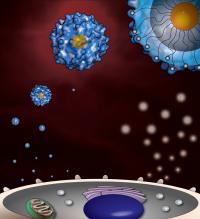
Gold particles modified with chemical residues interact with immune cells. Developing a drug or vaccine requires a delicate balancing act with the immune system. On one hand, medications need to escape detection by the immune system in order to perform their function. But vaccinations — de-activated versions of a disease or virus — need to do the reverse. They prompt the immune system to create protective antibodies. But scientists are still stumped by how the immune system recognizes different particles, and how it chooses whether or not to react against them.
Using nanoparticles made of pure gold, Dr. Dan Peer, head of Tel Aviv University's Laboratory of Nanomedicine at the Department of Cell Research and Immunology and the Center for Nanoscience and Nanotechnology, with a team including Drs. Meir Goldsmith and Dalit Landesman-Milo and in collaboration with Prof. Vincent Rotello and Dr. Daniel Moyano from the University of Massachusetts at Amherst, has developed a new method of introducing chemical residues into the immune system, allowing them to note the properties that incur the wrath of immune cells. Because the gold flecks are too small to be detected by the immune system, the immune system only responds when they are coated with different chemical residues.
This breakthrough could lead to an increased understanding of the properties of viruses and bacteria, better drug delivery systems, and more effective medications and vaccinations. Their study was published in the Journal of the American Chemical Society.
A tool for exploration
To begin probing the immune system, researchers used particles of gold, approximately two nanometers in diameter, and covered them with various chemical residues. Only when water-resistant residues were introduced did the immune system respond to their presence. That established a demonstrable link between hydrophobicity — the degree to which a molecule repels water — and the reaction of the immune system.
This idea has a basis in the normal functioning of the immune system, Dr. Peer explains. During cell death, the hydrophobic areas of the cell membrane become exposed. The immune system then realizes that damage has occurred and begins to alert neighboring cells.
The researchers discovered that the same principle held true for the chemicals added to the gold particles' surface. The more "water-hating" the particle is, the more actively the immune system will mobilize against it, he says.
Dr. Peer observes that this is only the first step in a long line of experiments. "We are using these gold particles to tackle the question of how the immune system recognizes different particles, which might include features such as geometry, charge, curvature, and so much more. Now that we know the tool works, we can build on it," he says.
Testing the "Danger Model"
Until now, scientists have developed theories about how the immune system functions, but have lacked the machinery to test these ideas. One such theory is the "Danger Model" by Prof. Polly Matzinger, which hypothesizes that cellular damage interacts with immune cells at the membrane level. Once they identify the foreign molecule as a "danger," the immune cells send signals throughout the immune system. Their initial experiment with hydrophobicity was designed to generate a toolbox for probing this theory, says Dr. Peer, whose investigations included both in vitro and in vivo experiments using mouse immune cells.
In the future, researchers will study various bacterial, viral, or damaged cells and to make the gold nanoparticles even more similar, thereby discovering which elements of dangerous particles are calling the body's immune system to arms. "We now have the capability of using nanomaterials to probe the immune system in a very accurate manner," says Dr. Peer, a breakthrough that could revolutionize the way we understand the immune system. Source : American Friends of Tel Aviv University
 Print Article
Print Article Mail to a Friend
Mail to a Friend
